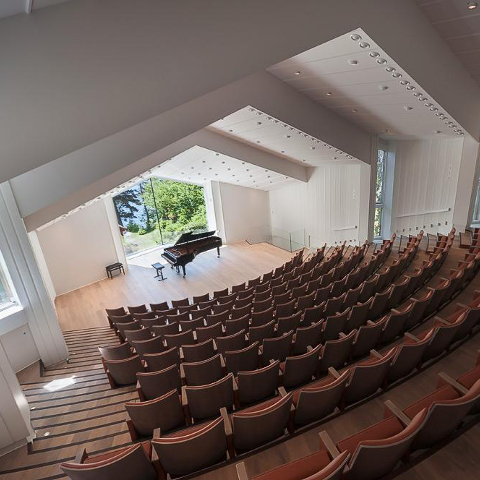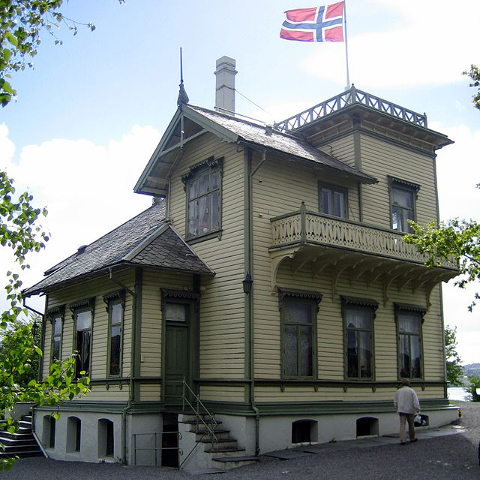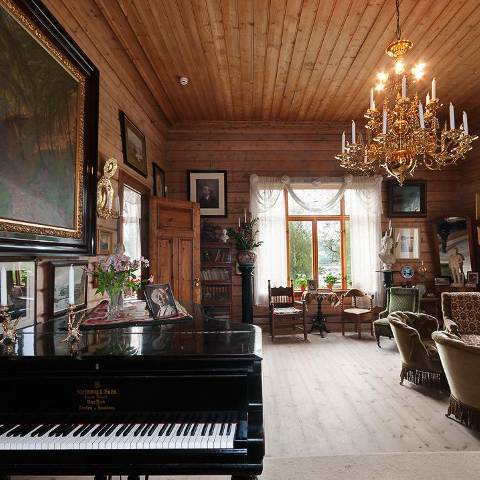Composers / Edvard Grieg / Places catalog
Grieg Museum
The new museum building was erected in the winter of 1994–1995, and it was opened by Queen Sonja on 25 May 1995. Besides a permanent display devoted to the composer, there are also rooms for temporary exhibitions, a multimedia room, a reception area with shop, visitor facilities, a cafe, storerooms and an office.
Built to a design by the architect Helge Borgen, the new museum has received a great deal of praise for its form and the choice of materials. Borgen’s winning design was entitled ‘Morgenstrek’, meaning morning joke or morning stroke, and it contains a number of elements of Grieg’s original villa, including large glazed areas, a tower and the use of wood. The black columns, meanwhile, represent a continuation of the trees surrounding the museum.
The permanent display leads us through the life and music of Edvard Grieg. It is a ‘see and read’ type display. The texts comprise a title, a large main text and details. They are complemented by photographic material and items in display cabinets, which afford us a peep into the composer’s realm. But only a visit to the villa, a perusal of the manuscripts, a large collection of which is held at Bergen Public Library, and a contemplation of Grieg’s music gives one the chance of really penetrating his world.
Hence the display itself represents no more than a useful background, giving us a foretaste of what awaits us in Grieg’s kingdom.
Standing in the middle of the exhibition room is a small statue of the composer, made by the great Norwegian sculptor Gustav Vigeland. This is a design for a monument that was to have been erected in 1915. Although that task was ultimately entrusted to another artist, Ingebrigt Vik, Vigeland made his statue and called it ‘Edvard Grieg Listening to Birdsong’ (Vik’s statue was unveiled in 1917 in the Municipal Park, and a replica stands in front of the Troldsalen concert hall).
In the multimedia room, one can watch the verbal-musical montage ‘In His Own Words’, illustrated with photographs and compiled from quotations from Grieg’s letters and articles, as well as a performance of his Ballade in G minor, Op. 25. The work of Eva Charlotte Nielsen and Svein Erik Amundsen, this montage was produced for the grand Grieg Exhibition in 1993 (the 150th anniversary of his birth) and won numerous international awards. In this same room, we also find an exhibition of Marvin Halleraker’s illustrations to the book The Little Grieg, published in 1993. Music can also be performed here.
The tapestry in the museum hall, entitled ‘Sign’, is the work of Jan Groth. Groth, who has lived abroad for many years (Denmark, the US), is among the world’s leading artists. He has a workshop in New York, where he teaches, and another in Copenhagen, and he maintains his links with Norway thanks to a third workshop, which he set up in his summer house in Dagala. His works can be found in major museums and galleries around the world, and the Stavanger Museum of Art has a large Groth collection. A tapestry by Jan Groth also adorns Gardermoen Airport, and perhaps his best known and one of his principal works is the curtain, embroidered on canvas, at Det Norske Teatret, with a surface area of 200 m² (1985).
The shop in the museum hall sells tickets and items produced exclusively for the Troldhaugen museum.
The elegant café offers refreshments and lunch, and one can even organise social gatherings here. So there are splendid opportunities to combine a visit to the museum with a concert and a culinary finale.
The downstairs exhibitions change every year. To date, they have included portrait photographs of Grieg with commentaries put together from quotations from the composer’s letters and articles (the bilingual album Edvard Grieg: Portrettene – The Portraits is available) and also drawings and caricatures in the exhibition ‘Grieg among his Friends and his Enemies’ (a book of that title is available in Norwegian and an exhibition catalogue in German and English.
-

Concert Sal, photo Dag Fosse, Edvard Grieg Museum.
-

Edvard Grieg Museum, photo Andreas Sandberg. (creative commons)
-

Inside of Grieg House, photo Dag Fosse, Edvard Grieg Museum.